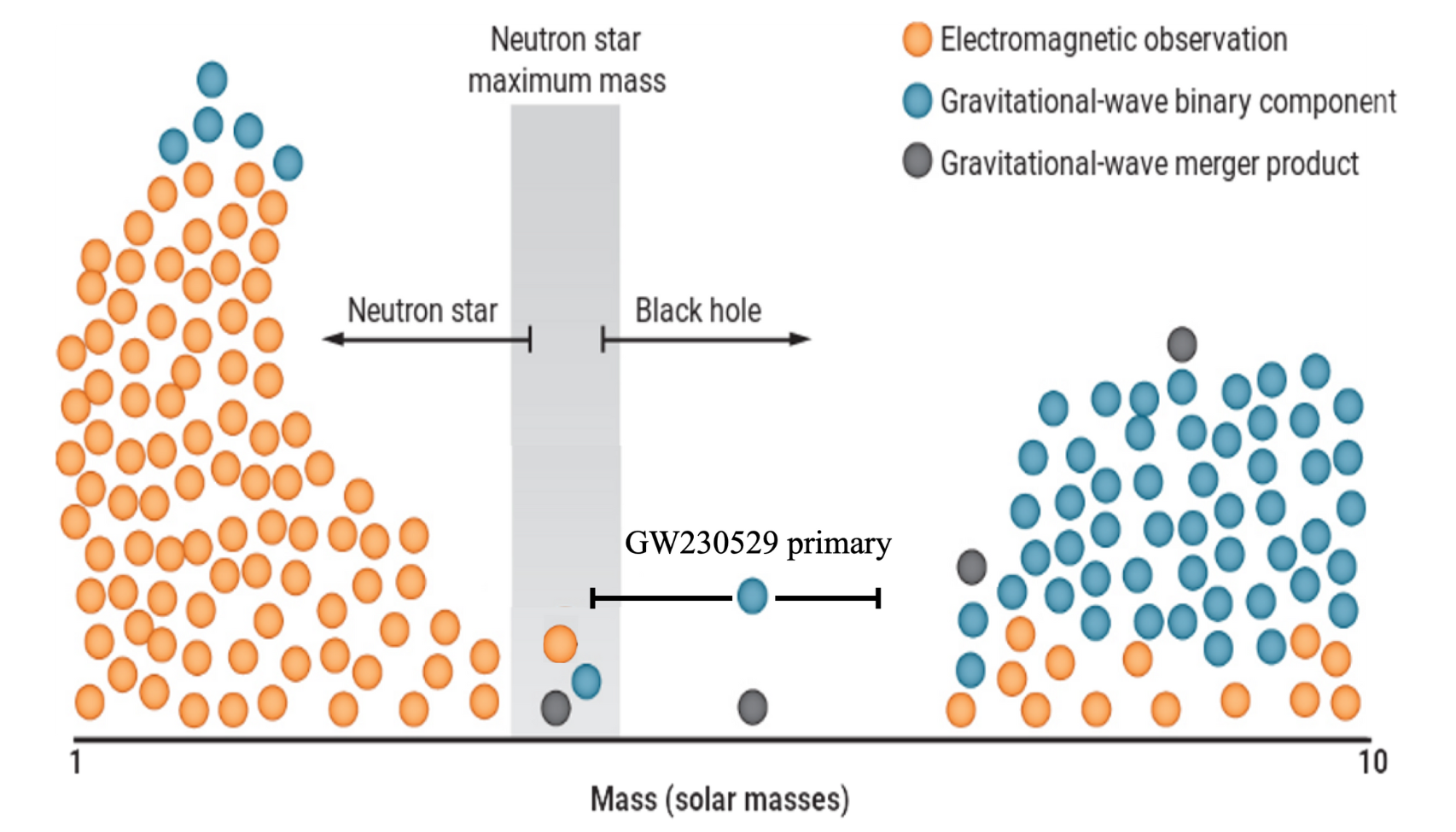Today the LIGO-Virgo-KAGRA (LVK) Collaboration released information on one of the events detected during its current fourth observing run — a gravitational-wave signal from the collision of what is most likely a neutron star with a compact object that is 2.5 to 4.5 times the mass of our Sun. What makes this signal, called GW230529, intriguing is the mass of the heavier object. It falls within a possible mass-gap between the heaviest known neutron stars and the lightest black holes. The gravitational-wave signal alone cannot reveal the nature of this object. Future detections of similar events, especially those accompanied by bursts of electromagnetic radiation, could hold the key to solving this cosmic mystery.
“GW230529 straddles a particularly interesting range of masses where we expect there could be both neutron stars and black holes. This signal’s astrophysical interpretation therefore requires knowledge of nuclear physics and the population of compact objects. The Canadian Institute for Theoretical Astrophysics (CITA) has expertise in both these areas, and our analyses guide the interpretation of this signal,” says Reed Essick, an assistant professor at the Department of Physics, cross appointed to CITA, who led the analysis to determine how likely it is that GW230529’s source contained a black hole.

Credits: K. Holoski/ Science/ M. Fishbach.
CITA faculty member Maya Fishbach and Essick, CITA Fellows Philippe Landry and Aditya Vijaykumar, and University of Toronto graduate students Utkarsh Mali and Aryanna Schiebelbein-Zwack have a longstanding involvement with the LVK, with Essick and Fishbach being part of the international collaboration since the detection of its very first significant events. To this day, gravitational-wave observations have observed around 100 mergers of compact objects. Out of these, only one other merger involved a mass-gap compact object similar to the one in event GW230529.
Analysis of signal GW230529 shows that it came from the merger of two compact objects, one with a mass between 1.2 to 2.0 times that of our Sun and the other up to twice as massive. While the gravitational-wave signal does not provide enough information to determine with certainty whether these compact objects are neutron stars or black holes, it seems likely that the lighter object is a neutron star and the heavier object a black hole.
Interpreting these signals relies on models of the astrophysical population of merging compact objects and the behaviour of extremely dense matter like that found in the cores of neutron stars. As such, it brings together expertise from the LVK’s Extreme Matter and Rates & Populations working groups, which are co-chaired by Landry and Fishbach, respectively.
Nuclear physics and general relativity limit the mass and spin that neutron stars can achieve. Based on previous work with Landry (Essick & Landry 2020) and Fishbach (Farah et al 2022), Essick combined our current understanding of high-density nuclear physics and the observed population of merging binaries to compute the probability that GW230529 is consistent with these bounds, finding that there is at least a 70 per cent chance that GW230529’s source contained a black hole.
“Gravitational waves continue to surprise us with discoveries of black holes and neutron stars with unexpected masses, unlike any of the compact objects that we see in our galaxy,” says Fishbach. “Understanding why the population of gravitational-wave sources differs from the Galactic population of compact objects can help us learn about the diverse formation histories of these systems.”
According to Landry, “previous gravitational wave and electromagnetic observations have hinted at the existence of compact objects in the 2 to 5 solar mass range, but this discovery is exciting because it is the first time we see a compact object from the purported mass gap paired with a neutron star. Gravitational waves are telling us that the gap is not empty.”
The fourth observing run is planned to last for 20 months including a couple of months break to carry out maintenance of the detectors and make a number of necessary improvements. By January 16, 2024, when the commissioning break started, a total of 81 significant signal candidates had been identified. GW230529 is the first of these to be published after detailed investigation. While the observing run continues, LIGO-Virgo-KAGRA researchers are analyzing the data from the first half of the run and checking the remaining 80 significant signal candidates that have already been identified. By the end of the fourth observing run in February 2025, the total number of observed gravitational-wave signals should exceed 200.

